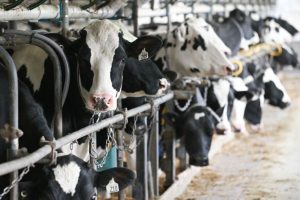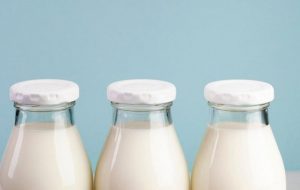
Strengthened use of all cheese was a key driver of this positive development. Meanwhile, U.S. dairy export volumes backed off a bit during the third quarter from their record pace during the prior quarter but kept the U.S. dairy industry on an almost certain path to set yet another calendar year record. Year-to-date performance through the third quarter was 18 percent of total U.S. milk solids production, up significantly from the current 17.3 percent calendar year record set in 2021.
The U.S. dairy industry has now clearly resumed increasing milk production after many months of below year-ago levels. Despite this greater supply, dairy product prices, which had been falling in recent months, found a floor and rebounded in some cases during October. Retail price inflation for all items, the categories of food and beverages, dairy products and for most individual dairy products moderated in October from a month earlier.
The Dairy Margin Coverage program generated a second payment for 2022, of $0.88/cwt for Tier 1 coverage at the $9.50/cwt level, in September. The CME Group dairy futures and USDA’s dairy outlook are currently indicating that milk prices will be about $2.50 to $3.00 per hundredweight lower in 2023 than this year.
Commercial Use of Dairy Products
The rolling 3-month changes from a year earlier in the domestic commercial use of milk in all products turned positive in September. These aggregate measures of consumption change in the U.S. market had been consistently negative since February. The recent change doubtless reflected positive trends in both retail and food service consumption, the two major drivers of Americans’ dairy foods consuming behaviors. American-type cheese consumption recovered during July–September from a spring and summer slump, while other cheese resumed stronger increases than those during the summer months. Fluid milk, yogurt and butter consumption, by contrast, have remained almost consistently in negative growth territory in the United States this year.
U.S. Dairy Trade
U.S. exports of American-type cheese declined by almost 20 percent during the July–September third quarter from their relatively high levels during the second quarter. Total cheese exports declined by just over ten percent over the same time. Total U.S. dairy exports backed off to 18.5 percent of total U.S. milk solids production from 19.3 percent as well. Nevertheless, third quarter export performance remained near record high levels, keeping the U.S. dairy industry on an almost certain path to set yet another record for export volumes during a full calendar year. U.S. dairy imports saw few significant developments during the third quarter, with a 15 percent annual increase in casein imports highlighting the period.
Milk Production
The USDA/NASS September milk production report revised the past several months of milk production data to now clearly show U.S. milk production rising again after many months below year-ago levels. The revised data show U.S. milk production rose over year-earlier levels by 0.5% in July, 1.7% in August and 1.5% in September. U.S. dairy cow numbers edged back above their level of a year earlier in September, following many months below. Total U.S. milk solids production gains again exceeded those of raw milk production by more than half a percentage point.
Dairy Products
Rising U.S. milk production during the third quarter of 2022 has yet to show up noticeably in the period’s dairy product production data, compared with the rolling three-month period a month earlier. Annual growth in all types of cheese, butter and whey products declined over those two periods.
Dairy Product Inventories
Cheese stocks kept falling in September from the record levels they reached at the end of July. While all types of cheese did so in August, the further drop in September was due entirely to non-American varieties. End of September butter stocks were 86 percent of their average level during the previous four Septembers. Dry skim milk inventories declined along with butter from August to September, while dry whey stocks were stable for the month.
Dairy Product and Federal Order Class Prices
As expected, dairy product prices that had been falling in recent months found a floor and rebounded in some cases during October. That month’s nonfat dry milk and dry whey prices were stable from September, while cheese prices staged a not insignificant rebound. Butter prices, which had yet to fall, reached another monthly high in October. These various product price behaviors caused a larger increase for the month in the October Class III price than that for Class IV. The gap between the two therefore narrowed in October, from almost five dollars per cwt to just over three.
As measured by the year-over-year rate of increase in their respective CPI’s, the most common measure of retail price inflation, the overall cost of living, general food and beverage inflation and overall inflation for dairy products and for most individual dairy product categories receded modestly in October from a month earlier. Butter was one of the few exceptions, with its annual CPI rise creeping up a tenth of a percent to 26.7 percent. This will also likely change soon, given the wholesale butter price drop in November.
Milk and Feed Prices
The September margin under the Dairy Margin Coverage program was $8.62/cwt, up by $0.54/cwt from the August margin and generating a payment of $0.88/cwt for Tier 1 coverage at the $9.50/cwt level under the program. The September U.S. average all-milk price rose $0.10/cwt from August. The DMC feed cost formula produced a $0.45/cwt lower feed cost for the month, due almost entirely to lower soybean meal and corn prices (numbers don’t add exactly due to rounding). Together, the September payment and the August one for $1.42/cwt will return more to producers enrolled for $9.50.cwt Tier 1 coverage than their annual premium payments.
Looking Ahead
Current forecasts indicate that, of the remaining three months in 2022, additional payments under the Dairy Margin Coverage program are most likely to occur in December. Dairy futures currently indicate the all-milk price will rebound in October and November from August and September levels. USDA’s Farm Service Agency opened enrollment for both calendar year 2023 DMC and for Supplemental DMC on Oct. 17. The deadline to enroll is Dec. 9.
USDA’s November World Agricultural Supply and Demand Estimates (WASDE) report made mostly modest downward adjustments from a month earlier to its product, class and all-milk price forecasts for calendar years 2022 and 2023. The CME-based forecasts at the time of the two reports showed much the same pattern for those same prices.
WASDE milk production forecasts in the November report were little changed from a month earlier, with an increase of just 100 million pounds for 2022 and no change in the 2023 forecast. The November forecasts indicate that 2022 production will be 0.3 percent higher than in 2021 and 2023 production will be up by 1.0 percent from this year. Taken together, the CME and the WASDE are currently indicating that milk prices will be about $2.50 to $3.00 per hundredweight lower in 2023 than during this year.






















